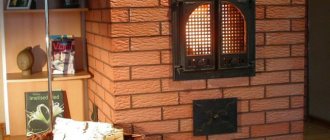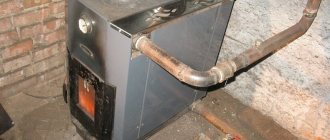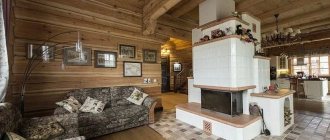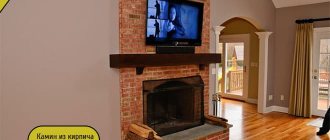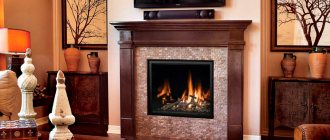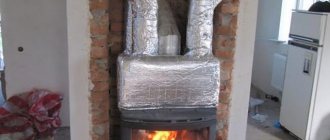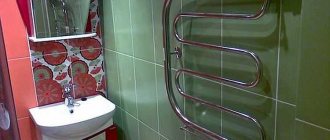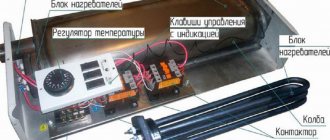How great it would be to have a beautiful fireplace in your house with a large glass door, and one so that the heat from the combustion of wood does not fly out into the chimney. So what's the problem? If after reading my article you have no doubts or new thoughts about installing a fireplace stove with a water circuit, then you can safely get down to business. And if they arise...
It is especially wonderful not to make excuses to yourself, your family and guests for your fireplace, its capriciousness, its specificity. Its small door or something else, which, in fact, often has to be sacrificed for the sake of the water circuit.
Of course, the matter is not only in the water circuit, but here we need to figure it out in order and “separate the flies from the cutlets”...
Heating systems
To heat the premises, a main line is required. Pipes through which water will circulate are suitable for this role. There is an open and closed heating system.
In the first case, the movement of water is carried out due to the inclination of the pipes. Convection promotes circulation to the very top, then water flows into other rooms, the level decreases each time and the water returns through the return line.
In the second case, the movement of water occurs due to forced circulation, which occurs due to the pumps swinging.
Additional features
The water fireplace has the following auxiliary elements:
- A, A1 – heat exchangers in the form of plates;
- 2 – device for cooking on a grill made of stainless steel 64/78 cm, 77 cm;
- 1 – electronic relay;
- 3 – external air flow intake device;
- E – flow sensor;
- G – three-way one-inch valve for regulating the water supply to the heating circuit;
- D – pump for forced circulation of coolant;
- C, B – set of valve mechanisms: safety valves (1.5 bar) and relief valves (at a temperature of 90 °C).
Application area
Often fireplaces with the possibility of water heating are installed in dachas or country houses, that is, where people do not live, but occasionally come, as well as in places where it is impossible to install gas. In addition to its main purpose, the fireplace-stove can be used as an interior decoration.
Another advantage of this system is its small size. Fireplaces have massive walls that heat up well and maintain a warm temperature in the room for a long time.
Criterias of choice
When choosing, most buyers are guided by cost and their own taste, paying attention only to the appearance of the product.
It is also advisable to take into account other factors:
- thermal power;
- durability;
- burning duration of a disposable fuel filler.
Power is determined depending on the size of the house area and the minimum outdoor temperature in winter. The manufacturer indicates the corresponding characteristics in the product passport. If they are not there or the numbers are very approximate, then you can use the calculation method from SNiP.
Then you need to consider:
- climatic conditions in the place of residence;
- design characteristics of premises;
- size of heated area;
- number of external walls;
- orientation of the external walls according to the cardinal directions - south, east, west, north;
- thermal resistance of external walls, depending on the thickness and thermal conductivity of the material;
- outside air temperature during the coldest week of winter;
- ceiling height;
- what is below/above: a heated or cold room, an attic - insulated or not;
- degree of floor insulation;
- presence of a basement;
- number/size of windows;
- window design: wood or metal-plastic, double or triple glazing, argon filling;
- presence/size of doors to the street or balcony.
Each room must be counted separately. Then sum up the heat loss - this is the maximum power of the heat-generating unit, which will still need to be increased by a safety factor of 15-20%.
Fireplace as a heating source
Using a fireplace, you can independently create a heating system in a private home. In this case, a fireplace with a water heating circuit acts as a universal mechanism.
It gives the space coziness and comfort and becomes a source of heating. The fireplace takes on the role of a boiler, but if the boiler is installed in a country house, it can be temporarily stopped, while the main boiler remains in operating mode.
It is permissible to use a fireplace in a “warm floors” system. The fireplace can be connected to the heating system as an alternative heat source.
Interior use
Do not forget that the key point in the name of the device is the word “fireplace”. This means that in addition to its technical qualities, it primarily serves as part of the interior. Various design options provide the opportunity to choose a model to suit any room decor.
Cast iron stoves and fireplaces are equipped with a heat-resistant glass door. It's easy to watch the flames through this glass, and it's also part of the slow-burning technology. Cast iron options are the most optimal in terms of performance and finish.
Some ready-made models do not require additional finishing, since they are covered with a layer of ceramics. The buyer only has to decide on the color of the fireplace. However, there are also options that will have to be additionally lined. This makes it possible to complete the decoration in the same spirit as the style of the room. Ceramics, artificial stone, and brickwork decor are excellent.
The presence of a circuit in the fireplace does not prevent the creation of different types of models according to the installation method. Due to its dimensions, a corner fireplace is suitable for a small room in a country house. This arrangement not only saves space, but also creates the illusion of increasing it. The corner model hides the transition boundary between the walls, so the eye is not “clung” to the dimensions and the room is externally assessed as a large space.
Pros and cons of fireplaces
Water-heated fireplace stoves have a number of advantages over traditional fireplaces.
- The price of a fireplace with water heating is relatively low.
- It can be easily connected to an existing heating system.
- Low fuel cost for this type of fireplace.
- The fireplace stove will fit into any interior and add comfort and coziness.
- Subject to fire safety, you can place the fireplace in any convenient place.
- The movement of water is carried out according to the laws of physics; no additional energy is needed.
- Easy to use.
- If desired, the owner can add a grill for cooking.
- Ball screen inserts can be added to save energy.
In addition to its advantages, any system also has a number of disadvantages.
- The efficiency of this type of fireplace is low, so they are not suitable for regions with very low temperatures. When operating it as an autonomous heat source, its efficiency will be approximately 40%.
- The fireplace must be constantly lit, which will be a significant disadvantage if it is used as the main source of heat.
Chimney
For fireplace stoves, ceramic chimneys or metal sandwich chimneys are recommended.
Ceramic chimneys are much more reliable and fireproof, but they are expensive and heavy.
Stainless steel is easy to install yourself, relatively cheap, but if overheated, there is a risk of burning.
Fireplace design
A fireplace with a water heating boiler has significant differences with a traditional fireplace, since in addition to its main function it has the ability to heat water. It has a metal container, thanks to which the water is heated.
The reservoir has the form of a coil, which allows you to increase the space for water. Water collects in it before filling the heating system.
There are ways to connect the water supply so that in addition to heating, there is hot water in the house.
The coil is located in a hollow space inside the fireplace filled with water. This prevents damage to the metal. Such an organization is called a water jacket. These types of fireplaces are often used in the country.
What does it consist of?
The design is extremely simple: body, firebox, heat exchanger. The housing can be free-standing. It is sometimes embedded in a solid wall or a decorative frame made of brick, forged or stone sculptures. The firebox is steel, but the grates are usually cast iron. Welded heat exchanger made of seamless pipes. An air duct is connected to the bottom of the firebox, and a chimney is connected to the top.
Frame
The metal casing of the aqua fireplace is hollow inside. Water circulates between the outer and inner walls. This is where its heating begins, and then it enters the upper register of the heat exchanger. As a result of this technical solution, the outer shell cannot even theoretically heat up above 100 °C, therefore it is completely fireproof.
A hob is sometimes placed on the upper plane. This design is relevant for small country houses, where the kitchen, dining room and living room are combined in one room.
The geometry of the case depends only on the designer’s imagination. The main thing is that the combustion chamber fits in it.
The combustion chamber
Conventional fireplaces had a low efficiency of 20% due to imperfect heat extraction during fuel combustion. The room was heated by the infrared radiation of the flame. There was a large portal in front so that the rays from the fire could warm the maximum area of the room.
Additionally, a small amount of heat warmed the air in the house due to convective heat transfer from the hot body. The remaining 80% of the heat escaped through the chimney along with combustion products - hot gases.
The design of aqua fireplaces provides for the possibility of changing the fuel burning rate by regulating the flow of supply air into the lower part of the firebox. The portal is closed with heat-resistant glass. It blocks uncontrolled access of air to the fire, which makes the aqua fireplace fireproof.
To reduce the likelihood of drafts, provide for the flow of air into the firebox through a pipe. A fine grill to keep rodents and cats away is installed outside. There is an adjustable damper in front of the fireplace.
On top of the portal there is a “clean glass” system - a longitudinal slot with guides for a small amount of fresh air from the room. A stream of cold air “flows” along the inside of the glass, preventing soot contamination.
Heat exchanger (water heating circuit)
In the upper part of the firebox there is a register of pipes for collecting heat from hot gases. The coolant, water, flows inside the pipes. If the power of the aqua fireplace is very high, then additional registers are placed along the side and rear walls of the firebox. To improve heat transfer and increase efficiency, there must be a circulation pump. As a result, the efficiency of the aqua fireplace increases to 80%.
When heated, water increases its volume, so it is necessary to install an expansion tank. With an open heating system, it is installed at the highest point - usually in the attic. When closed, the membrane-type tank is mounted in any place convenient for maintenance. A pressure gauge and a safety valve are mounted nearby.
Chimney
Ceramics or metal are used to remove gaseous combustion products. Ceramic chimneys are durable, but expensive and labor-intensive to install.
The smoke channel pipe is glazed during manufacture. This prevents soot from sticking and makes cleaning easier. It is separated from the chimney body by heat-resistant thermal insulation. At the bottom there is a container for collecting condensate.
Main characteristics of ceramic chimneys:
- service life - over 25 years;
- glassy surface prevents soot deposition;
- fireproof;
- do not burn out;
- a significant mass must rest on the foundation;
- high cost of components;
- complex installation.
Metal chimneys are much cheaper and easier to assemble. If the operating mode is violated, they may burn out.
Steel pipes are assembled using a sandwich design. The inner pipe made of technical stainless steel is separated from the outer one by fiber-basalt thermal insulation. Individual blocks are joined using heat-resistant sealant.
Characteristics of metal chimneys:
- the cost of purchase and installation is less than that of ceramics;
- it is possible to assemble it yourself;
- light weight, so no foundation is needed;
- Do not allow the flame to break through into the chimney.
Making your own fireplace
Creating a fireplace with your own hands can be divided into two parts: building the body and the heat exchanger. For construction you will need drawings and special materials suitable for building a fireplace with a water jacket. The shirt will additionally need to be edged with steel.
Construction begins with laying the foundation. For the foundation, it is necessary to dig a hole in the ground, which will be slightly larger in size than the size of the future building. Materials required for the foundation:
- To create a wooden form you will need boards.
- Ruberoid.
- Sand.
- Crushed stone.
- Cement.
The surface of the foundation should be flush with the surface of the floor. First you need to cover the surface with roofing felt as waterproofing. You will need a clay mixture as a mortar, and fireproof bricks are needed for the fireplace.
- You can prepare the solution yourself using clay and sand in the required proportions, or buy a special mixture in a specialized store.
- Creation of the structure must begin horizontally, regardless of the type of fireplace.
- Afterwards, it is necessary to form an ash pan and proceed to installing the heat exchanger when the formation of the firebox is almost complete, otherwise it will not be possible to install the heat exchanger.
- The heat exchanger is a small tank with two flat disks for connecting pipes.
- The first work is needed to supply cold water, the second is needed to drain hot water. The heat exchanger must be made of metal with a thickness of at least 4 mm.
To make a heat exchanger, you must have welding skills. An experienced craftsman can weld sheets of iron in the form of a coil.
Material
The material from which the housing and heat exchanger are made is also important.
Steel stoves are lightweight, but short-lived. Cast iron stoves are more expensive and more reliable, but they are heavy and fragile and can crack if the temperature changes.
The best option is combination furnaces, in which highly heated parts are made of cast iron, and the rest are made of steel. If desired, the fireplace can be faced with brick.
Completion of construction
After welding of the heat exchanger is completed, it is located in the cavity of the fireplace. At the last stage, the construction of the fuel chamber and the formation of the chimney occurs.
- Next, you need to wait until the solution dries completely.
- It may take 7 to 10 days for complete drying.
- It is necessary to carefully inspect the seams and joints to avoid leaks.
When using a fireplace with water heating on wood, you need to design the inclusion and disconnection of the circuit from the system. It is permissible to turn off the water during the summer and use the fireplace as a source of fire.
Fuel requirements
Hornbeam, oak, birch or aspen logs are ideal for lighting the stove. When burning, they emit less soot and smoke.
You should not buy coniferous wood, cherry, willow and elm. They are characterized by a large amount of resin and soot. Logs can produce sparks, which increases the risk of fire and negative impact on human health.
Firewood should be lit with birch bark, wood chips, paper products or a special liquid. It is imperative to ensure that during the process the gate valve is open all the way and that there is sufficient aeration in the ash pit.
By the way, the usual wood-burning stoves-fireplaces are far from the only type. For some time now, they have been in no way inferior in popularity to gas, electric analogues and those that run on special biofuel.
Finishing work
The finished structure can be finished with finishing material. There is a wide variety of different materials, but stone and marble are used most often. These materials can give the interior a luxurious look.
In addition to natural stone and wood, you can use simple plaster, which will cost several times less.
The plaster can match the shade of the floor. There is an option not to decorate the fireplace at all; it will look beautiful on its own.
Payment for the order
1. Payment in cash to the courier upon delivery of the goods (only for residents of Moscow and the Moscow region) or at the pick-up point.
2. Payment by bank transfer to the organization's current account according to a pre-issued invoice. The price for some products may be changed for this type of payment.
3. Payment by credit card upon delivery of goods (only for residents of Moscow and the Moscow region). It is necessary to warn the manager about this payment method when placing an order.
4. Payment by credit card from the site. When placing an order, notify the manager that you want to pay from the site. The price for some products may be changed for this type of payment.
5. Payment by electronic money.
6. Payment through terminals.
If you have chosen to pay in cash to the courier or by credit card upon delivery of the goods, then you can pay for the purchase directly with the courier of our store at the time of delivery of the order. Payment is accepted only in Russian rubles upon delivery of goods and transfer of all necessary documents. This payment method is only available to individuals.
For individuals living outside the Moscow region and receiving goods through a transport company, as well as for legal entities, payment is made in cashless form to the store’s bank account. In this case, payment for the order is made according to the issued invoice, which you can receive at the fax number or email address you specified.
Photos of fireplaces with water heating
Payment for the order
1. Payment in cash to the courier upon delivery of the goods (only for residents of Moscow and the Moscow region) or at the pick-up point.
2. Payment by bank transfer to the organization's current account according to a pre-issued invoice. The price for some products may be changed for this type of payment.
3. Payment by credit card upon delivery of goods (only for residents of Moscow and the Moscow region). It is necessary to warn the manager about this payment method when placing an order.
4. Payment by credit card from the site. When placing an order, notify the manager that you want to pay from the site. The price for some products may be changed for this type of payment.
5. Payment by electronic money.
6. Payment through terminals.
If you have chosen to pay in cash to the courier or by credit card upon delivery of the goods, then you can pay for the purchase directly with the courier of our store at the time of delivery of the order. Payment is accepted only in Russian rubles upon delivery of goods and transfer of all necessary documents. This payment method is only available to individuals.
For individuals living outside the Moscow region and receiving goods through a transport company, as well as for legal entities, payment is made in cashless form to the store’s bank account. In this case, payment for the order is made according to the issued invoice, which you can receive at the fax number or email address you specified.
Advantages of the unit
Angara 12 from Meta
The Angara fireplace has the following advantages that distinguish it from other similar products:
- large combustion chamber, which allows the use of firewood 0.5 m long;
- ease of installation, which makes it possible to install the heating device yourself;
- all surfaces are easy to clean from soot and soot;
- the glass door is equipped with a “clean fire” system, which significantly extends the service life of the device and allows it to be used for a longer period;
- high productivity due to the use of a secondary combustion system, which allows you to use energy not only from solid fuel, but also from gases that are formed during the combustion process of the stove;
- low wood consumption due to the introduction of a long-burning system.
Also, a significant advantage of the Meta Angara 12 stoves is the presence of a hob in some models, which makes it possible to use this unit not only for heating living quarters, but also for cooking.
Date: September 25, 2022
